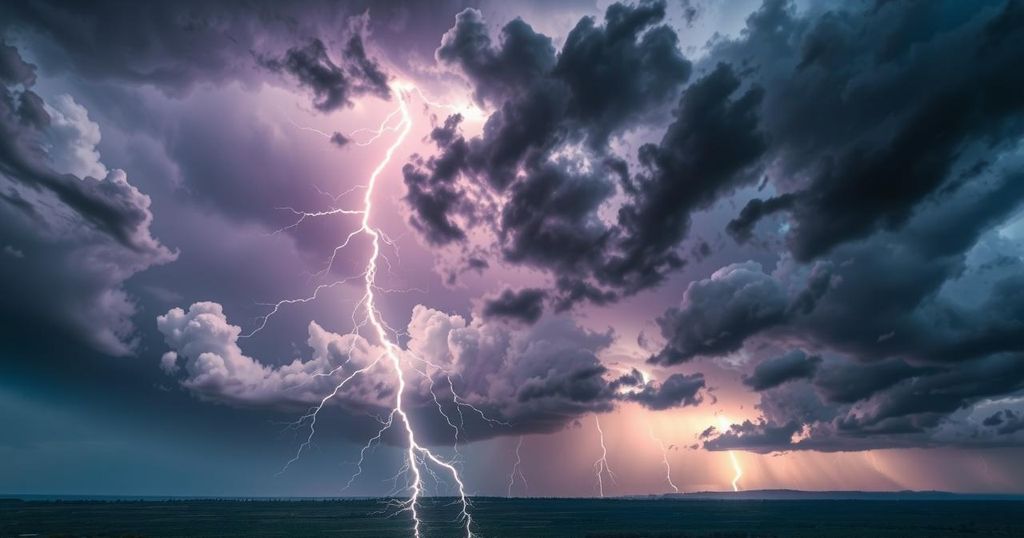Severe Storms and Climate Challenges in Eastern Australia: An Urgent Call for Action
A severe weather crisis is unfolding in eastern Australia, with nearly 2 million lightning strikes recorded and significant storm-related incidents reported. The NSW SES is overwhelmed with calls for help as storms have led to injuries, fatalities, and widespread power outages. The Commonwealth’s funding issues are exacerbating the situation, and the growing frequency of such events prompts urgent discussions on climate change policy and emergency service preparedness.
Recent severe storms have resulted in nearly 2 million recorded lightning strikes across eastern Australia, prompting the New South Wales State Emergency Services (NSW SES) to respond to over 7,000 storm-related incidents since Wednesday morning. The intense weather is forecasted to continue through the weekend, with thunderstorms affecting the east coast and a tropical cyclone developing off the Western Australia coast, leading to concerns of gale-force winds in the region.
Queensland and Western Australia are currently grappling with a severe heatwave, while heavy rainfall warnings have been issued for the NSW coast. This has led to protective evacuations, such as at Ferndale Caravan Park due to flood risks, highlighting the severity of the storms. Meteorologist Christie Johnson explained that these storms were caused by a cold front, creating a storm line from Queensland to Tasmania, covering an impressive distance of over 1,500 kilometers.
The storms have claimed lives, including the tragic death of an 80-year-old man in Cowra when a tree fell on his vehicle. Four other individuals were injured in Wagga Wagga when a demountable hut was overturned by strong winds. Weatherzone reported an astounding 1.8 million lightning strikes across Queensland to Tasmania over a 24-hour period, showcasing the tempestuous conditions affecting the region.
The fierce storms not only caused fatalities and injuries but also disrupted power supply, with around 200,000 homes in regions like Illawarra and Sydney experiencing outages due to downed trees and powerlines. Recent storms have minimally restored power, yet as of Thursday morning, approximately 28,000 homes in Sydney and 15,000 in Newcastle remained without electricity. Notably, Sydney’s Crown Casino also suffered damage when lightning penetrated its roof, leading to flooding inside the building.
In Carlingford, the storm’s impact resulted in significant structural damage, including a roof being blown off a house, forcing 14 residents to seek temporary housing. Additionally, fires ignited in Mudgee when lightning struck a dwelling, and in Dubbo where it hit a tree, causing a gas pipe to leak. Wind gusts exceeding 100 km/h were observed during the storms, and localized rainfall reached dramatic levels, causing flash floods and putting emergency services under significant stress.
As the wild weather continues, flood warnings have been issued affecting a 400 km area from Coffs Coast to Newcastle, with specific advisories for campers to avoid rivers. The rapid weather changes have caused previous heatwave warnings to be rescinded. A report by the Commonwealth Scientific and Industrial Research Organisation (CSIRO) indicated that Australia’s climate is increasingly characterized by more extreme weather, including heavier rainfall and prolonged droughts.Histories of inadequate funding for emergency services have resulted in their unpreparedness for these escalating natural disasters, with the SES relying heavily on a volunteer workforce of 10,000.
The Labor government has faced criticism for its continued approval of coal mines despite climate change science calling for reductions in emissions. The CSIRO’s report warns that climate change impacts will lead to more frequent and intense rainfall events and longer droughts, necessitating an urgent overhaul of our societal structures to meet these challenges. The complexities of climate change call for a united response from the working class to prioritize human civilization over profit-driven motives.
Severe weather events in Australia, characterized by intense storms and heatwaves, underscore the increasing frequency of climate-related disasters. Recent reports indicate a troubling trend in climate impacts, including increased rainfall and severe heat conditions across various regions. Emergency response services, overwhelmed by the demands of such events, have faced criticism regarding their readiness and capacity. Given the country’s reliance on volunteers for emergency services and enduring funding challenges, the advances in climate science further highlight the urgency for reform in national policies on climate change.
In summary, eastern Australia is currently experiencing unprecedented storm activity and extreme weather events, marked by millions of lightning strikes and severe flood risks. Tragically, these storms have resulted in loss of life, injuries, and extensive damage to properties. There is a clear need for improved emergency preparedness and a reassessment of governmental policies regarding climate change, as the impacts are becoming increasingly dire. Collective action towards addressing the root causes of climate-related disasters is essential for future resilience.
Original Source: www.wsws.org




Post Comment